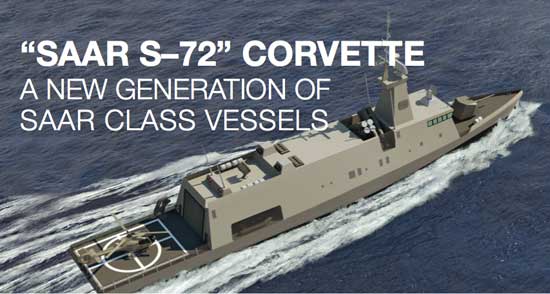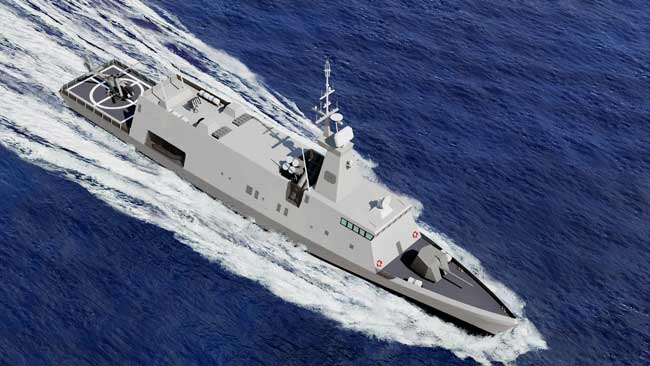The Javelin shoulder-mounted anti-tank missile system.
Javelin is a portable anti-tank weapon, supplied by Raytheon / Lockheed Martin Javelin joint venture. It is shoulder-fired and can also be installed on tracked, wheeled or amphibious vehicles.
In 1989, the US Army awarded a contract for the development of Javelin as a replacement for the M47 Dragon anti-tank missile. The Javelin joint venture was formed by Texas Instruments (now Raytheon Missile Systems) of Dallas, Texas and Lockheed Martin Electronics and Missiles (now Missiles and Fire Control), of Orlando, Florida.
Raytheon is responsible for the command launch unit (CLU), missile guidance electronic unit, system software and system engineering management. Lockheed Martin is responsible for the missile seeker, missile engineering and assembly.
Javelin entered full-rate production in 1994 and the systems were first deployed in June 1996 by the US Army at Fort Benning, Georgia.
"Javelin is a shoulder-fired, portable anti-tank weapon."
The Javelin system saw operational service with the US Army and Marine Corps and Australian Special Forces during Operation Iraqi Freedom in March / April 2003 and is currently deployed in Afghanistan. The CLU is also being used in surveillance operations. The standalone mode usage of CLU was proved to be effective in target detection and battle field reconnaissance when it was deployed in Afghanistan and Iraq. More than 2,000 rounds have been fired by the US and coalition forces.
The missile achieved a higher range of 4,750m during a demonstration in February 2013.
Javelin procured for light forces anti-tank guided weapon system (LFATGWS)
In January 2003, the UK Ministry of Defence announced that it had decided to procure Javelin for the light forces anti-tank guided weapon system (LFATGWS) requirement. The initial order was for 18 launchers and 144 missiles. Javelin replaced the Milan system and entered service with British Army in July 2005.
Javelin equips the army's rapid reaction forces, including 16 air assault brigade, three commando brigade and mechanised infantry. BAE Systems and a number of other UK companies are providing subsystems for the missiles. In October 2004, a further order was placed, to equip the armoured infantry and formation reconnaissance forces from 2007, replacing the Swingfire ATGW.
Javelin anti-tank missile orders and deliveries
Over 25,000 missiles have been produced and over 6,600 command launch units sold to the US Army and Marine Corps. Javelin has also been selected by Taiwan (60 launchers and 360 missiles), Lithuania, Jordan (30 launchers and 110 missiles), Australia (up to 92 systems and 600 missiles), New Zealand (24 launchers, delivered in June 2006), Norway (90 launchers and 526 missiles, delivery from 2006) and Ireland.
In June 2004, the Czech Republic signed a Letter of Agreement (LOA) with the US government to provide the Javelin system. In November 2004, the United Arab Emirates requested the foreign military sale (FMS) of 100 Javelin launchers and 1,000 missile rounds. In June 2006, Oman requested the FMS of 30 launchers and 250 missiles. In July 2006, Bahrain requested the FMS of 60 launchers and 180 missiles. Contracts for the supply of the missile system to UAE and Oman were placed in July 2008. In October 2008, Taiwan requested the sale of an additional 182 missile and 20 launchers.
Six more nations are considering deployment of the Javelin system. Canada has also been authorised to make such a purchase, but has not pursued the option to date. India has also proposed purchasing Javelin system through the FMS route and is expected to issue a letter of request (LoR) to the US Government. The LoR will include procurement of third generation anti-tank guided missile along with transfer of technology. The final number of Javelin systems is yet to be decided, but may run into thousands. France ordered 260 missiles and 76 launchers for $69m.
Production of the block 1 missile began in 2006. Successful qualification firings took place in January 2007.
In December 2008, the Javelin JV was awarded a contract to upgrade 404 block 0 command launch units to block 1 configuration.
"The Javelin anti-armour missile is autonomously guided to the target, leaving the gunner free to reposition or reload immediately."
In July 2009, the Javelin JV was awarded a five-year, $298.6m support contract for the Javelin anti-tank missile and command launch unit. According to the contract, the US Army will be provided with repair support, depot spares, training and data. The JV received another contract from the US Army in October 2009 for the production of the Javelin close combat weapon system. The $214m contract includes the Javelin missile, CLUs, training and field support.
The Javelin JV received a $176m contract in December 2009 from the UK Ministry of Defence for over 1,300 Javelin missile rounds and related engineering support. The delivery of the missiles began in 2010 and will carry on through 2012.
The US Army awarded a $309m contract to the Javelin JV in August 2010 to produce Javelin missile-firing systems for infantry troops. The first Javelin missile was fired from the Common Remote Operations Weapon Station II (CROWS II) mounted on a Stryker IFV in December 2010.
Qatar has also requested for the FMS of 500 Javelin guided missiles in March 2013, according to the Defense Security Cooperation Agency.
Javelin anti-armour missile
The Javelin system consists of the CLU and the round. The CLU, with a carry weight of 6.4kg, incorporates a passive target acquisition and fire control unit with an integrated day sight and a thermal imaging sight.
The sight uses DRS Technologies second-generation thermal imaging technology, based on the standard advanced Dewar assembly (SADA IIIA). The company also provides the quieter, dual-opposed piston coolers for the sight.
The gunner's controls for the missile system are on the CLU. The day sight is equipped with x4 magnification and the night sight with x4 and x9 magnification optics.
The round consists of the Javelin missile and the ATK (Alliant Techsystems) launch tube assembly. The range of the missile is 2,500m. Javelin is a fire-and-forget missile with lock-on before launch and automatic self-guidance.
The missile is equipped with an imaging infrared seeker which is based on a cadmium mercury telluride (CdHgTe) 64 x 64 staring focal plane array in the 8 to 12 micron waveband. BAE Systems Avionics is providing the infrared seekers for the British Army's missiles.
The tandem warhead is fitted with two shaped charges: a precursor warhead to initiate explosive reactive armour and a main warhead to penetrate base armour. The propulsion system is a two-stage solid propellant design which provides a minimum smoke soft launch.
The block 1 missile upgrade includes an improved rocket motor that reduces time of flight, an enhanced warhead effective against a greater range of targets, 2,500m of improved probability of hit / kills and improvements to the command launch unit and software. In 2008, the improved block 1 missile full materiel release was received and the US Army has stockpiled the first production lots. Other improvements include a digital display, software processing enhancement and remote view of the gunner display in an RS-170 standard video format. The future Javelin will have fragmentation for anti-personnel effects and a multipurpose warhead (MPWH) with shaped charges for armoured vehicles.
Javelin missile system operation
The system is deployed and ready to fire in less than 30 seconds and the reload time is less than 20 seconds. The missile is mounted on the CLU and the gunner engages the target using the sight on the CLU, by placing a curser box over the image of the target. The gunner locks on the automatic target tracker in the missile by sending a lock-on-before-launch command to the missile. When the system is locked-on, the missile is ready to fire and the gunner does not carry out post launch tracking or missile guidance.
"The Javelin system is deployed and ready to fire in less than 30 seconds and the reload time is less than 20 seconds."
Unlike conventional wire guided, fibre-optic cable guided, or laser beam riding missiles, Javelin is autonomously guided to the target after launch, leaving the gunner free to reposition or reload immediately after launch.
A soft launch ejects the missile from the launch tube to give a low-recoil shoulder launch. The soft launch enables firing from inside buildings or covered positions. Once the missile is clear, the larger propellant in the second stage is ignited and the missile is propelled towards the target. The weapon has two attack modes, direct or top attack.
The gunner selects direct attack mode to engage covered targets, bunkers, buildings and helicopters.
The top attack mode is selected against tanks, in which case the Javelin climbs above and strikes down on the target to penetrate the roof of the tank where there is the least armour protection.
The missile is launched at an 18° elevation angle to reach a peak altitude of 150m in top attack mode and 50m in direct fire mode.
The Global Missiles and Missile Defence Systems Market 2011-2021
This project forms part of our recent analysis and forecasts of the global missiles and missile defence systems market available from our business information platform Strategic Defence Intelligence. For more informationclick here or contact us: EMEA: +44 20 7936 6783; Americas: +1 415 439 4914; Asia Pacific: +61 2 9947 9709 or via email.



















 Scud-B
Scud-B Scud-C
Scud-C Rodong
Rodong